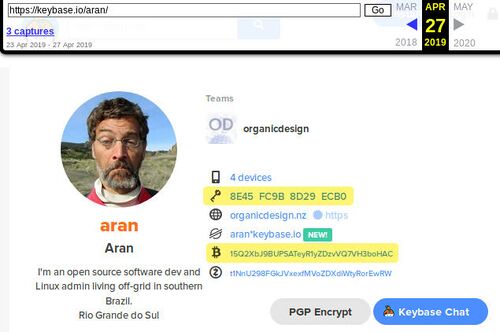Difference between revisions of "Proof of agreement"
(New article) |
(No difference)
|
Revision as of 00:03, 4 August 2019
This article will cover a simple method using freely available tools for people to create an agreement amongst themselves which is digitally signed by all participants. The agreement is created in such as way that the identity of all participants, the authenticity of their signatures, and the time the agreement was signed can be verified by anyone. These verifications are very strong, but don't rely on any third-party authority and can be carried out by anyone using freely available tools without any specialised skills or knowledge.
Public key cryptography
Public key cryptography is the kind of system where the owner holds a secret private key that gives them ownership over the resource the key is protecting, and an associated public key which is safe to share publicly. Two popular example are PGP keys and Bitcoin addresses.
With PGP key pairs, anyone can use a public key to encrypt information knowing that only the person holding the private half of that key will be able to decrypt it. Also, the holder of the private key can sign messages resulting in a digital signature than anyone can verify using the public key. When someone sends a message they can sign it with their PGP key so that the recipient can use the sender's public key to ensure that the message was really sent by the holder of the private key.
In the case of Bitcoin, anyone can send money to any public bitcoin address, knowing that only the holder of the associated private key will be able to spend that money. As with PHP, the holder of the private key is also able to sign messages with it, and anyone can verify that the signature is valid using the public key.
Publicly identifying yourself with a key
The first part to being able to create verifiable agreements between people, is being able to verify an irrefutable connection between a physical person and a public key they hold.
If you haven't already done so, you can publish any of your public keys either on your own site, or on a site that supports various forms of keys in user's profile information such as Keybase, OneName or some of the social networks such as Mastodon. For the purpose of creating a good agreement, it's a good idea to use a recognisable profile picture and include other details such as web site and email addresses in your profile.
This information may be solid at the time the agreement was made, but we want to make an agreement that can stand the test of time. The profile page you've chosen to use for the agreement may not be very permanent, for example the domain could expire, the company running the site go bankrupt or you may decide to delete your account and move to another platform.
A very useful tool to help us with this problem is the "Wayback Machine" at web.archive.org. This site has snapshots of billions of web pages at specific times to preserve the history of the web. And if by chance your profile does not exist in the Wayback Machine when you search for it, you will be given the option of adding it right then.
Below is a concrete example. I have a profile in a platform called KeyBase - or at least I did have at the time I wrote this! There were a few snapshots of my profile page already in the Wayback Machine when I checked just now, which you can see in the following picture, or by going there yourself.
This is a frozen snapshot of time, no matter what happens with Keybase in the future or what happens to my specific Keybase account, this snapshot will continue to exist in the Internet Archive. You can see that this profile relates a number of things together; it has my name (full name would be better for this purpose) and photo, some of my web addresses and two public keys (highlighted). For most people there would also be provable connections with Facebook and Twitter etc, but I have deleted all such accounts out of my life!








